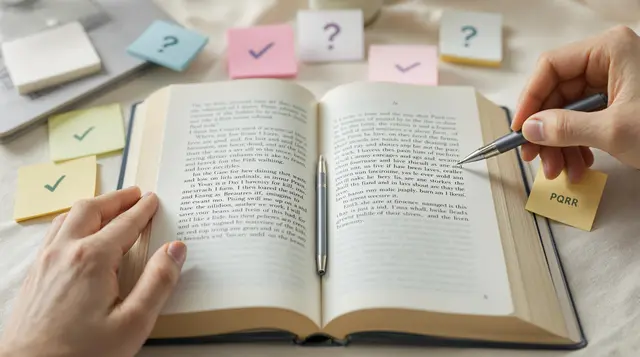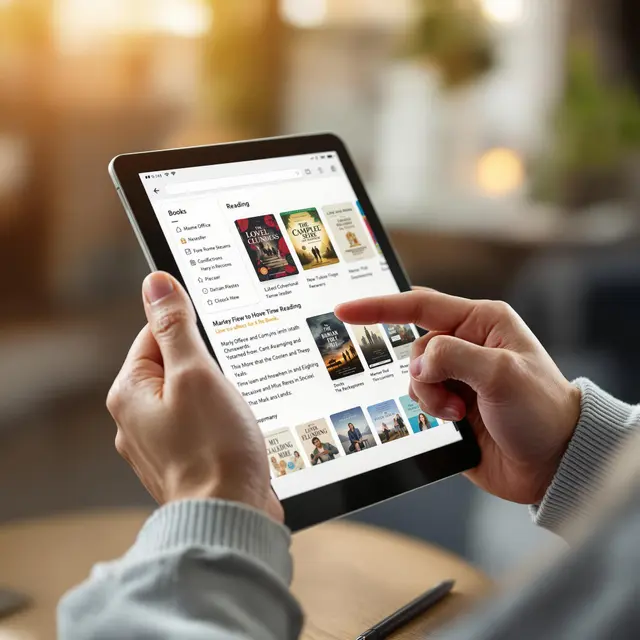
Remember when you last looked at your growing pile of unread books and felt that familiar pang of guilt? We’ve all been there. Whether you’re a student drowning in textbooks, a professional trying to keep up with industry literature, or simply an avid reader with an ever-expanding reading list, the ability to read faster while maintaining comprehension isn’t just a luxury—it’s a necessity in our information-rich world.
Pro Tip: Before starting this journey, download a reading speed calculator app like ReadTracker or Speed Reading Test Pro to accurately measure your progress throughout the week.
The Science Behind Speed Reading

Before diving into techniques, let’s understand what happens in your brain when you read. Traditional reading often involves subvocalization—that inner voice pronouncing each word—which typically limits us to 200-400 words per minute. This speed mirrors our natural speaking pace, but our brains can actually process visual information much faster.
Research from MIT’s Department of Brain and Cognitive Sciences shows that the human brain can process images in as little as 13 milliseconds. By training ourselves to reduce subvocalization and enhance visual processing, we can dramatically increase our reading speed while maintaining—and sometimes even improving—comprehension.
Important Note: Studies have shown that combining visual and auditory learning can increase retention by up to 75%. Keep this in mind as we explore multi-sensory reading techniques.
The 7-Day Speed Reading Transformation – You will be a Reading Pro After This!
Day 1: Establishing Your Baseline and Breaking Old Habits

Start by measuring your current reading speed:
Choose a book at your reading level
Read for exactly one minute, marking your starting and ending points
Count the words to calculate your Words Per Minute (WPM)
Take a moment to write down 3-4 key points from what you just read
Recommended Apps for Day 1:
- Spreeder: Free online tool for tracking reading speed
- Reading Trainer: Comprehensive app with baseline testing features
- Acceleread: Provides detailed analytics of your reading patterns
Breaking the Subvocalization Habit:
Listen to instrumental music (specifically baroque music at 60 BPM like Bach’s Air on G String)
Use the “Hum Method”: Hum quietly while reading to occupy your vocal cords
Practice with speed reading apps like Spritz or ReadMe! that display one word at a time
Start with comfortable speeds (300 WPM) and gradually increase by 50 WPM increments
Quick Tip: Set up a distraction-free reading environment. Use apps like Freedom or Cold Turkey to block notifications during your practice sessions.
Day 2: Mastering Eye Movement Patterns

Your eyes make small jumps (saccades) and brief pauses (fixations) while reading. Efficient readers make fewer fixations per line, taking in more words with each eye stop.
Exercise: The Triangle Method
Draw an inverted triangle on your page (base width: 3-4 words, height: 3-4 lines)
Focus your eyes at the top points of the triangle
Let your peripheral vision catch the words between these points
Gradually increase the width of your triangle (aim for 6-8 words eventually)
Advanced Eye Training Apps:
- Accelareader: Helps train peripheral vision
- Eye Exercises: Strengthens eye muscles
- Flash Reader: Improves word chunk recognition
Scientific Insight: Research shows that expert readers can process up to 8-10 words per fixation, compared to the average reader’s 1-2 words.
Day 3: Advanced Visual Tracking Techniques

The S-Pattern Technique:
- Use a soft-tip pen or your index finger as a pacer
- Move in a smooth S-pattern down the page at these speeds:
- Morning practice: 2 seconds per line
- Afternoon practice: 1.5 seconds per line
- Evening practice: 1 second per line
- Your eyes naturally follow this fluid motion
- This reduces regression (re-reading) and maintains forward momentum
The Parallel Processing Method:
Use a ruler or bookmark to divide each page into three vertical sections
Train your eyes to process these sections in parallel
Start with wider columns (2 inches each) and gradually narrow them
Use apps like Column Reader or ReadingGym that format text in columns
Expert Tip: Professional speed readers often use a combination of techniques, switching between them based on the material’s difficulty and their energy levels.
Day 4: Cognitive Enhancement Strategies

Memory Anchoring:
- Before reading, use mind mapping apps like MindMeister or XMind
- Create a pre-reading checklist:
- Scan chapter titles and subheadings
- Review any charts, graphs, or images
- Read the first and last paragraphs
- Note any bold or italicized text
- Set specific learning objectives using the SMART framework
The Conceptual Chunking Technique:
- Use color coding for different types of information
- Create concept maps using tools like Coggle or MindNode
- Practice with specialized apps like Chunk Reader
- Group ideas into these categories:
- Main concepts (highlight in yellow)
- Supporting details (highlight in blue)
- Examples/applications (highlight in green)
- Key terms/definitions (highlight in pink)
Productivity Hack: Use the Pomodoro Technique with your reading practice: 25 minutes of focused reading followed by 5-minute breaks.
Day 5: Advanced Comprehension Techniques

The Preview-Question-Read-Review (PQRR) Method:
- Preview: Use tools like Blinkist or GetAbstract for book summaries
- Question: Create focused questions using the QuestGen technique:
- What are the main arguments?
- How does this connect to what I know?
- What are the practical applications?
- Read: Apply your speed reading techniques with apps like QuickReader
- Review: Use active recall apps like Anki or RemNote
Comprehension Enhancement Tools:
- Readwise: Syncs highlights across devices and sends daily review prompts
- MarginNote: Creates interactive mind maps from your readings
- LiquidText: Allows dynamic document annotation and linking
Research-Based Tip: Studies show that writing a 2-minute summary immediately after reading can increase retention by up to 40%.
Day 6: Digital Reading Optimization

Essential Digital Reading Apps:
- Pocket: Clean, distraction-free reading interface
- Instapaper: Customizable fonts and spacing
- Outread: Guided reading with visual pacers
- BeeLine Reader: Uses color gradients to guide eye movement
Optimal Digital Settings:
- Font: Use Sans-serif fonts like Arial or Verdana
- Size: 14-16pt for optimal recognition
- Line spacing: 1.5 to 1.8
- Background: Sepia or light gray (reduces eye strain)
- Screen brightness: 50-75% in well-lit conditions
The Scroll-and-Process Technique:
- Use apps like Spritz or ReadMe! that control text presentation
- Start at 400 WPM and increase by 50 WPM every hour
- Take comprehension tests using apps like Reading Trainer Pro
Tech Tip: Enable “Night Shift” or “Blue Light Filter” on your devices to reduce eye strain during extended reading sessions.
Day 7: Integration and Sustainability
Creating Your Personal Reading System:
- Use reading tracking apps:
- Goodreads for general tracking
- StoryGraph for detailed analytics
- Reading Challenge for goal setting
- Set up a progressive practice schedule:
- Morning: Technical reading (30 minutes)
- Afternoon: Business/professional reading (45 minutes)
- Evening: Leisure reading (60 minutes)
Maintenance Tools and Techniques:
- Speed Reading Timer Pro: Regular speed tests
- Focus@Will: Concentration-enhancing music
- Forest App: Distraction blocking and focus tracking
Achievement Marker: By day 7, aim to read at least 700 WPM with 80% comprehension for general texts.
Beyond the 7 Days: Advanced Applications
Different Speeds for Different Materials
Technical Material (300-400 WPM)
Use Kindle X-Ray feature for technical terms
Implement the Cornell Note-taking system
Focus on diagrams and illustrations first
Business Reading (400-600 WPM)
Use executive summary techniques
Focus on action items and key metrics
Implement the SCQA framework (Situation, Complication, Question, Answer)
Leisure Reading (600-800+ WPM)
- Practice with fiction using natural chunking
- Use visualization techniques
- Focus on plot progression and character development
The Metacognitive Advantage
Modern speed reading apps like Elevate and Lumosity incorporate metacognitive training:
- Reading comprehension games
- Pattern recognition exercises
- Memory enhancement activities
Common Pitfalls and Solutions
- Regression Habits
- Use the AccelaReader pacer tool
- Practice with apps that prevent backward eye movement
- Set progressive daily goals using Reading Challenge Pro
- Comprehension Anxiety
- Use Mindfulness apps like Headspace before reading sessions
- Regular comprehension checks with Quiz Creator
- Focus on main ideas using summarization tools like Quillbot
- Inconsistent Practice
- Use habit tracking apps like Strides or HabitBull
- Join online speed reading communities on Goodreads
- Participate in reading challenges with specific WPM goals
Conclusion: The Journey Continues
Remember, speed reading is not about rushing through books—it’s about processing information more efficiently. With these techniques, apps, and consistent practice, you can significantly increase your reading speed while maintaining or even improving comprehension.
Final Tip: Create a personalized toolkit combining your favorite apps and techniques. Remember that what works best for you might be a unique combination of different methods.
The real victory isn’t just reading faster; it’s having more time to explore new ideas, learn new skills, and enjoy more of the written word. As you continue practicing these techniques beyond the initial seven days, you’ll find yourself naturally reading faster and understanding more deeply.
What starts as a conscious effort will become second nature, opening up a world of possibilities for learning and growth. So take that first step today—your growing library of unread books is waiting to be explored.


